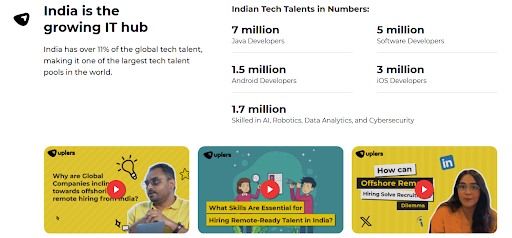Understanding Staffing Alternatives: An Overview
- Prachi Shah
- January 24, 2025
- 6 Minute Read

Staffing is an imperative factor of business success. An organization may consider expansion of operations, prioritize launching of new products, or think of implementing new technologies, it would need new talent.
The right staffing structure and the best staff determine your business agility and growth. Modern businesses are constantly compelled to fill skill gaps, cut costs, and be more efficient. Thus, it is critical to understand staffing alternatives.
The objective of this guide is to provide insight in overviewing staffing alternatives, especially for businesses that want to hire IT talent, employ full-time employees, or hire remote talent.
Let’s explore outsourcing and staffing agencies that can help you make the best staffing decisions for the organization!
What are Staffing Alternatives?
Today, 90% of hiring managers are struggling to find suitable candidates for their businesses. The average time it takes to fill a new position is approximately 42 days. Such incapacities lead to lost productivity and high recruitment costs. Thus, there is a dire need for organizations to consider staffing alternatives.
Definition – Staffing alternatives are different kinds of hiring approaches used by businesses to ensure the required workforce. These include full-time workers, remote employees, contractors, or outsourced offshore teams.
Diversifying staffing techniques means catering to various kinds of demands like to hire remote talent, reducing costs, hiring IT talent from off-shore sources, and accessing global talent.
Organizations need to consider various staffing alternatives, because of the following reasons:
- Scale teams up or down to fit project requirements.
- Save on operational costs by engaging remote or outsourced people.
- Access skills are unavailable locally.
- Tap the larger talent pool, including IT and development roles.
Let us understand about different kinds of staffing options!
A. Full-Time Employees

Full-time employees are workers who are hired for a fixed number of hours, according to the organization’s policies and the labor laws of the country. They usually have many benefits and are not extended to part-time or contract workers.
Advantages of Full-Time Staff
- Full-time employees stick to the company’s long-term plans.
- Training full-time staff encourages in-house skills development.
- Employees need to adhere to company policies, compliance laws, culture, and vision.
- Full-time workers can be contacted during work hours.
Limitations of Full-Time Staff
- Employing full-time employees is expensive. The costs of employing full-time workers include their salaries, benefits, insurance, and office overhead. Other drawbacks are:
- Increasing or reducing teams becomes very costly and time-consuming.
- They are bound to a fixed schedule and location.
Full-time employees are best suited when organizations need to:
- Stabilize core roles.
- Fill roles for long-term projects or leadership positions.
- Manage critical processes.
B. Remote Workers

The revolution in technologies has accelerated growth in remote workers. Globally, 16% of organizations are fully remote, and 83% of the workforce prefers hybrid work.
Advantages of Remote Staff
- You can recruit any talent worldwide and save money on office space and operational costs.
- Studies show that remote developers are13% more productive than on-site employees and 81% of employees are satisfied.
Limitations
- Time zones and virtual meetings can be quite a challenge.
- Other drawbacks are data security across borders and keeping the team intact.
Best Practices to Manage Remote Employees
- Clearly define what is to be delivered and by when.
- Use modern tools to make communication seamless.
- Keep checking on the persons for goal alignment and interest.
- Use secured systems to keep the company’s data safe.
C. Outsourcing and Offshore Staffing

Outsourcing means contracting a third party, either in an agency or offshore teams, to provide specific tasks. Very common in IT, software development, and customer support, it allows a business to leave the core staffing areas to third parties that have the expertise.
Advantages of Outsourcing
- Offshore staffing can cut labor costs by 70%.
- One of the best staffing alternatives to hire IT talent and skilled employees for AI, and cloud solution services.
Drawbacks
- Quality may suffer if the agency does not properly vet their staff.
- Communication can break down.
- Dependence on external teams may reduce in-house expertise.
Best Practices in Outsourcing
- Select staffing agencies with a successful past performance.
- Supply expected deliverables, deadlines, and expectations.
- Review performances on KPI.
- Collaborate without the issues arising from communication gaps across departments.
Staffing Agencies and Recruitment

So, are staffing agencies worth it?
The answer is a clear YES! Staffing agencies link employers with skilled candidates to fill temporary, permanent, or contract positions. It saves time and money in the recruitment process and ensures that businesses source the right talent within the shortest time possible.
Benefits of Hiring Remote Developers Using Staffing Agencies
- Staffing agencies reduce the average hiring time from 42-45 days to 17-19 days.
- Agencies maintain a pool of pre-vetted candidates.
- Agencies provide contract, contract-to-hire, and full-time staffing solutions.
- Saves costs on job postings, background checks, and initial screening.
Factors to Consider While Selecting a Staffing Agency
- Choose agencies with IT expertise or your industry niche.
- Clear pricing models and terms.
- Seek reviews of clients, case studies, and success rates.
How to Choose Staffing Alternatives?
Here are key ways in which you can choose the best from the given staffing alternatives:
1. Consider Business Needs and Goals
Every organization is unique in its staffing requirements. Consider short-term and long-term objectives to identify which staffing model will work appropriately. Here are some tips:
- It is best to hire remote talent if you need temporary workers for a particular project or seasonal workload.
- Companies that are not sure about long-term commitments can hire contractors.
- Hire IT talent to get the right skills at a competitive cost.
2. Understand Budget Constraints
One of the significant determinants while comparing different alternatives in terms of staffing is budget. Consider the following:
- Staffing agencies may seem expensive at first but save the valuable time and effort invested in the recruiting process.
- Hire remote talent to save overheads of offices, infrastructure, and employee benefits for the company.
- Hire IT talent to source developers and IT professionals on a project or an hourly basis, which may be much cheaper than internal staffing.
3. Flexibility and Scalability
Flexibility is the name of the game for modern business, as companies need to keep adapting to the market’s ever-changing demands. Here are some tips:
- Contract and remote staffing options allow for scalable solutions.
- Hiring remote developers allows you to access professionals from various time zones, enhancing productivity and efficiency.
- Businesses with fluctuating demands can hire remote talent on demand and remain agile without making long-term commitments.
4. Legal and Compliance Issues
Legal and compliance implications are crucial when choosing staffing alternatives:
- The employer must comply with labor laws, terms of contract, and classifications of employees.
- When hiring remote workers across international borders, consider the complexities of tax regulations, employment laws, and data security.
- Partner with trusted staffing agencies to simplify legal compliance through managing employment contracts, intellectual property rights, and local labor regulations.
Uplers – Your One-Stop Solution!

Uplers is a trusted partner when you are looking for the perfect staffing alternative. Whether you’re hiring remote developers, contracting IT professionals, or scaling your team, Uplers simplifies the process with a wide talent network and leading-edge solutions.
Why choose Uplers?
- Access pre-vetted remote developers and IT specialists from around the world.
- Get up to 20%-50% discount in hiring while ensuring quality talent.
- Hire on-demand talent matched to your business needs
- We take care of the complex law, contracts, and payroll so you can focus on your core business
Uplers has empowered more than 7,000+ global businesses with top IT talent, who have experienced 96% client satisfaction, 70% talent match success rate, 15X faster hiring than tech recruitment norms, and 93% reduction in hiring time compared to others.
Conclusion
Selecting from the best staffing alternatives depends on your business goals, budgetary constraints, flexibility needs, and compliance requirements. Options such as contract staffing, remote hiring, and IT outsourcing offer a wide range of benefits, including cost savings, scalability, and access to the best global talent.
Use staffing alternatives such as hiring remote talent or outsourcing an IT role to scale efficiently, be cost-effective, and provide access to unmatched expertise.
Frequently Asked Questions
What is the difference between full-time and remote employees?
Ans – Full-time employees are employed for regular work and are eligible for benefits and perks. Remote employees can work from any location in the world, which may provide greater flexibility and savings.
What are the advantages of outsourcing IT talents?
Ans – To hire IT talent, outsourcing staffing needs means cost-cutting, access to international skills, and shortening delivery time. Companies get the benefit of a global workforce who can specialize in the most recent technological skills.
How will remote employees benefit my business?
Ans – A remote workforce brings flexibility, reduced operational costs, and access to talent that may not be geographically located near a company’s offices. They also may boost productivity by working across time zones.
What are some legal considerations when selecting a staffing alternative?
Ans – When employing international or remote workers, some core legal considerations are compliance with local employment laws, taxation, intellectual property rights, and data privacy laws.

Thank you for submitting the details!
We will keep your information safe. Feel free to contact us with any questions at hello@uplers.com
Please check your email for next steps shared by Robert.

















